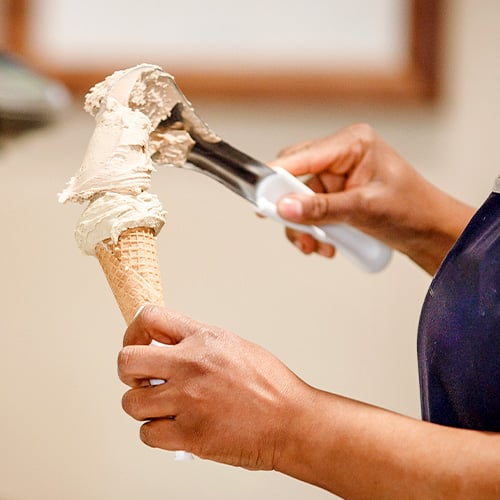Enjoyed by children and adults alike, ice cream is a classic summer treat. The industry has expanded in recent years thanks to emerging types of frozen treats, the growth of the mobile vending industry, and the normalization of pop-up and seasonal shops. For many, getting ice cream with friends and family is a summer ritual, meaning there is plenty of demand for local ice cream shops. Check out our ice cream shop startup guide and learn how to open your own ice cream business.
Shop All Ice Cream Shop Supplies
Skip to the ice cream shop startup information that interests you:
Ice Cream Shop Concepts and Branding
Ice Cream Shop Business Plans
Ice Cream Shop Start-Up Costs
How to Secure Funding for a New Business
Business Licenses and Permits
Ice Cream Shop Locations
Ice Cream Shop Menu
Ice Cream Shop Decor
Ice Cream Shop Advertising Ideas
Ice Cream Shop Openings
What Type of Business Is an Ice Cream Shop?
An ice cream shop is a business that primarily sells ice cream but may also specialize in other frozen treats such as milkshakes, gelato, frozen yogurt, and sorbet. Each frozen treat has a unique preparation method. Ice cream shop owners offer a wide range of toppings from classics like chocolate syrup to inventive options like bubble tea add-ins. One of the biggest appeals of ice cream shops is customization because customers can order their favorite frozen treats to their preference. For owners, opening an ice cream shop is an attractive option since they don’t require expansive kitchens or seating areas. They can be profitable businesses since ice cream is a popular food, especially in the summer.
Opening an Ice Cream Shop
Opening an ice cream shop may seem like an overwhelming task at first. However, breaking down the process into steps makes it easier to tackle. Follow our 10-step guide to opening an ice cream shop.
1. Ice Cream Shop Concepts and Branding
Choosing an ice cream shop concept and brand is the first step in opening an ice cream shop. It is here where you’ll decide how your shop serves customers and what type of industry trends you incorporate into your ice cream shop’s business model. When it comes to ice cream shops, there are a few major concepts and branding options you need to consider before moving on to the next steps of planning.
Seasonal vs Year-Round Ice Cream Shops
Ice cream is often considered a seasonal food that is mostly consumed in the spring and summer. Unless you operate in a year-round warm climate, your ice cream sales will taper during the fall and winter months. Many ice cream shops are only open seasonally, opening around the first day of spring and closing during the waning days of summer. Alternatively, your ice cream shop can stay open during the colder months, hoping that a solid product, loyal customer base, or diverse menu will continue bringing people through the door when the weather gets colder.
Ice Cream Trucks
Food trucks are gaining traction in the broader food industry, but they aren't a new concept in the ice cream business. A neighborhood ice cream truck is iconic, and a visit from one is the highlight of a summer day for children. Starting an ice cream truck over a traditional brick-and-mortar location gives you the chance to be mobile and go directly to consumers. Doing so can increase impulse sales and lower overhead costs. However, ice cream trucks must deal with inconveniences such as limited space, parking regulations, permits, and insurance.
Fixed Menu vs Self-Service Ice Cream Shops
One of the newer trends in the ice cream industry is self-serve ice cream shops. Traditionally, ice cream shop customers order from a menu of select items. However, a new wave of modern ice cream shops has changed the formula, allowing customers to customize their frozen treats at various stations before charging customers based on product weight.
2. Ice Cream Shop Business Plans
Writing an effective business plan is a critical part of starting an ice cream shop. A business plan gives you a medium to outline your goals, strategies, and budget all in one location. A financial document like a business plan will come in handy down the line when you’re attempting to impress lenders and investors to secure funding for your ice cream shop. To create a comprehensive overview of your ice cream shop, your business plan should contain the following:
Executive Summary - The executive summary is written last because it provides a brief overview of all the information included in your business plan.
Company Description - In this section provide a written description like your executive summary but expand upon specifics such as strategies and projections.
Concept and Menu - This section explains what concepts you have chosen for your ice cream shop and outlines the items you plan to offer on your menu.
Management and Ownership Structure - Discuss what type of ownership your ice cream shop will have and how your management team will be set up.
Employees and Staffing Needs - This section should outline how many employees you’ll need to operate your ice cream shop and what positions must be filled.
Marketing and Competitor Analysis - Identify a target market and complete a comprehensive analysis of nearby competitors to find potential competitive advantages.
Advertising and Marketing Strategies - List potential advertising and marketing methods to entice customers and establish brand loyalty.
Financial Projection and Summary - In this section, outline sales projections, perform a break-even analysis, and list potential expenses.
For an in-depth guide to writing a business plan, check out our restaurant business plan guide.
3. Ice Cream Shop Start-Up Costs
While not as pricy as opening a restaurant or some other foodservice locations, opening an ice cream shop still requires capital. Typically, opening an ice cream shop will cost you anywhere between $20,000 to $50,000. However, this figure can vary based on whether you decide to buy or rent a location and whether you purchase new or used equipment. Here are a few of the most important expenses you’ll have to cover when starting an ice cream shop:
Down Payment - Purchasing a food truck or brick-and-mortar for your ice cream shop is a major expense. Although a loan is usually taken out for such a large sum, expect to make a down payment of around 15-20% of the cost.
Property Renovations/Construction Costs - Purchasing a location or food truck is rarely enough to be ready for opening. Plan to spend money on renovations and construction.
Ice Cream Shop Equipment - To produce, store, and sell ice cream, investments in a variety of appliances and equipment are needed. Required equipment includes ice cream makers, refrigerators, and freezers.
Ice Cream and Supplies Inventory - Buying all the necessary ice cream ingredients, containers, and utensils for your ice cream shop can be costly.
Employee Wages - Running an ice cream shop will require a handful of managers,
employees, and staff who need to be paid a reasonable salary.
Advertising - An advertising budget is needed to run marketing campaigns and bring new customers through the door.
POS System - A POS system is a big help in streamlining the ordering process, inventory management, and sales reporting, making it a great investment for new ice cream shops.
Permits and Licensing - Opening an ice cream shop requires you to receive several permits and licenses, some of which come with fees.
4. How to Secure Funding for a New Business
There are several ways that you can secure funding and ensure that your dream of owning an ice cream shop becomes a reality. Determine how much money will be required for the initial start-up, as the figure will determine what funding option best fits your needs.
Self-Funding - You may be able to fund portions of your ice cream shop with your personal funds. Tapping into savings accounts and retirement plans can provide you with funds and control over your business, but that means you assume all of the risks yourself.
Lenders - Small business loans and traditional commercial loans can provide you with enough funding to get your business started. Interest rates may mean you’ll be paying more in the long run, but a loan means you won’t need to immediately put up your personal finances or give away equity.
Venture Capital - Venture capital is a form of private equity financing that is usually given to new businesses in exchange for equity. Finding an investor for your business is a great way to secure the funds required for an ice cream shop start-up. An investor can prove to be a valuable business partner, but giving up equity and other concessions are major drawbacks.
Crowdfunding - Crowdfunding involves a community of people pooling together payments to reach a goal. Contributors are often rewarded with special prizes or discounts, incentivizing consumers to contribute.
5. Business Licenses and Permits
Before you can legally open your ice cream shop and begin making sales, you'll need to acquire the right business licenses and permits. A few of the most important ones are listed below but double-check with local laws and seek legal counsel to ensure your ice cream shop has everything it needs to open.
Business License - Business licenses are the legal requirements for you to operate in your industry and location, and as a result, they may vary based on location.
Employee Identification Number - Your ice cream shop will require a nine-digit employee identification number before you can hire employees and staff. Every business in the United States has a unique employee identification number for identification purposes.
Seller’s Permit - A seller’s permit legally authorizes your business as a collector of sales tax. Many states and local areas require a seller’s permit, so be sure to double-check your state and local laws.
Health Permit - To sell any prepared food product, a health permit confirming safety and sanitation is required. Health permits are usually handled by county and local governments, meaning laws and regulations regarding health permits can vary greatly from location to location.
Back to Top
6. Ice Cream Shop Locations
The location you choose for your ice cream shop is an important part of executing your vision and making your initial concepts a reality. While those starting an ice cream truck business don’t need to worry about location too much, for brick-and-mortar stores, a good location is vital. Perform a location analysis to determine the best location, maximize profits, and attract customers is highly recommended. While looking for an ice cream shop location, there are several features that you should keep in mind.
Space - Your ice cream shop location needs to have enough space to house several appliances, a serving area, and possibly a seating area for customers.
Foot Traffic - An ideal ice cream shop location is an area that receives plenty of foot traffic, resulting in impulse buying from customers.
Seasonal Traffic - Ice cream shops make most of their profits during the summer months, so a location that receives more traffic in the summer, like a shopping center across from a public pool or beach access point, is ideal.
Overhead Costs - Lack of sales during the fall and winter months means an ice cream shop location ideally has low overhead costs to offset low sales during tough times. Some of the most common overhead costs you should look to save on include rent and utilities.
7. Ice Cream Shop Menu
Putting together a solid selection of items for your menu is critical to bringing customers through the door and ensuring that they come back. You'll want to make sure that your menu pricing is affordable for consumers but still generates profits. Creating an ice cream shop menu is a tight balancing act, as you need to bring classic ice cream flavors customers expect while also standing out from the competition. Outside of ice cream, there are a few different items that you should consider adding to your menu.
Milkshakes - Sweet drinks made by blending a mixture of ice cream, milk, and various flavorings. Offer malted milkshakes for an old-timey ice cream shop menu item with universal appeal.
Floats - A unique creation that consists of a large scoop of ice cream served in a glass with root beer or another soda.
Italian Ice - A classic way to cool off on a hot summer day, Italian ice is made from water, sugar, and natural or artificial fruit flavorings.
Gelato - While it’s similar to ice cream in appearance and flavor, gelato often contains less fat, is churned at a slower speed, and is served at a warmer temperature.
Mangonada - A popular Mexican frozen beverage, magonadas are made from ripe mangoes, lime juice, chamoy sauce, and chili-lime salt seasoning.
Frozen Yogurt - As the name suggests, frozen yogurt is made with yogurt, milk, and cream, resulting in a tangier taste than ice cream.
Popular Ice Cream Flavors
Ice cream shops offer a wide range of flavors, but there are a handful of common flavors that customers expect. Here are a few of the most common flavors that will guarantee sales for your ice cream shop:
Vanilla
Chocolate
Strawberry
Cookies and Cream
Mint Chocolate Chip
Lactose Free Ice Cream
Lactose intolerance affects millions of people in the United States, directly impacting their ability to enjoy ice cream and other dairy products. Lactose-free ice cream can either be made by filtering the lactose out of the milk used in ice cream, or by adding synthetic lactase enzymes into dairy milk. Offering a selection of lactose-free ice cream on your menu is a great way to cater to guests with alternative diets, and it can be a competitive advantage over other ice cream shops that don’t have similar offerings.
Dairy Free Ice Cream
Similar to lactose-free ice cream, dairy-free ice cream takes the process a step further and eliminates dairy from the recipe. A substitute is used in its place, usually an ingredient like almond milk or coconut milk. Dairy-free ice cream is a great addition to your menu as it not only appeals to lactose-intolerant customers but also vegan customers. Vegan menus are growing in popularity, so offering ice creams that vegans can order may boost sales and help your ice cream shop establish a niche customer base.
8. Ice Cream Shop Decor
The setup and design of your ice cream shop help tell your brand story. Many people have a specific idea of how ice cream shops are stylized, usually with bright colors and loud, cheery music. Common colors used in ice cream shop design include bright reds, pinks, and teals as well as patterns such as polka dots and stripes. However, you may want to stray away from the classic ice cream parlor aesthetic and follow emerging foodservice design trends instead. Beyond decor, there are areas of your ice cream shop that need to be created with functionality in mind.
Serving/Dispensing Stations - Traditional ice cream shops will need to dedicate a large area for storing the ice cream meant for serving. Typically, several large freezer ice cream cabinets are required to store the flavors. The more modern variants of ice cream shops that charge by weight won’t require this, but they will require ice cream dispensers to be placed around the store.
Weighing Stations - Ice cream shops that charge by weight will need several weighing stations for customers to weigh their creations and determine the price.
Seating - Most ice cream shops require some form of seating area for customers to enjoy their ice cream. Ideally, an ice cream shop should offer both indoor and outdoor seating so customers can choose based on the weather.
9. Advertising Ideas for Ice Cream Shops
When starting any new business, it's important to let people know that you have opened and are ready for business. The best way to do this is by engaging in advertising campaigns to entice customers. Thankfully in today’s digital world, there are several ways you can effectively advertise your business and reach your target market. Try generating hype and building excitement with these ice cream shop advertising ideas:
Establish a Strong Website - In today’s business climate, creating a solid website is a requirement for a business. A website is an easy location for customers to learn everything they need to know about your business. In the past, creating a website was a daunting task, but there are now several platforms on the Internet that can help you design a basic yet attractive website.
Social Media Outreach - Using social media advertising to attract customers is a great way to secure more business. Social media is becoming more prevalent in our daily lives and requires minimal time and effort to use, making it an attractive advertising option.
Digital Presence - Several websites such as Yelp, OpenTable, and Tripadvisor play an important role in how customers decide to shop. Ensure that your business is registered on these websites, as well as free tools such as Google My Business to maximize your brand exposure.
Promotions and Sales - Special deals and sales are a great way to get customers to check out your ice cream shop. The prospect of savings and good deals will catch the attention of consumers, and once they try your quality product, there will likely come back for more.
Loyalty Programs - Rewarding customers for frequently buying your product is a great way of establishing brand loyalty and securing repeat customers. Implementing loyalty programs such as digital punch cards, special member statuses, and targeted deals and promotions will not only attract new customers but will keep those you already have coming back.
10. Ice Cream Shop Openings
As the time to open your ice cream shop to the public nears, you’ll have to decide how you’ll want to handle your ice cream shop opening. The biggest decision you’ll have to make when opening your ice cream shop is whether you want to host a soft opening, a grand opening, or both.
Soft Opening vs Grand Opening
A soft opening is a simulated opening with real customers that allows your shop to test menu items, service flow, and customer capacity. While a soft opening isn’t required, working out all the potential kinks before your ice cream shop officially opens can be beneficial.
A grand opening is a special celebration designed to mark the start of your business. Grand openings sometimes have special offers, exclusive menu items, or live events to generate hype and celebrate the opening of the shop. Hosting a grand opening event is a great way to launch your business, and immediately entice customers to check out your new shop.
Back to Top
Ice cream is one of the most popular foods in the United States and brings people together. We all have memories of getting ice cream on hot summer days with loved ones. For those looking to offer those experiences to a new generation of people while simultaneously running a profitable business, opening an ice cream shop is the perfect opportunity.
<aside class="pquote">
<blockquote>
The information provided on this website does not and is not intended to constitute legal advice. Please refer to our Content Policy for more details.
</blockquote>
</aside>






